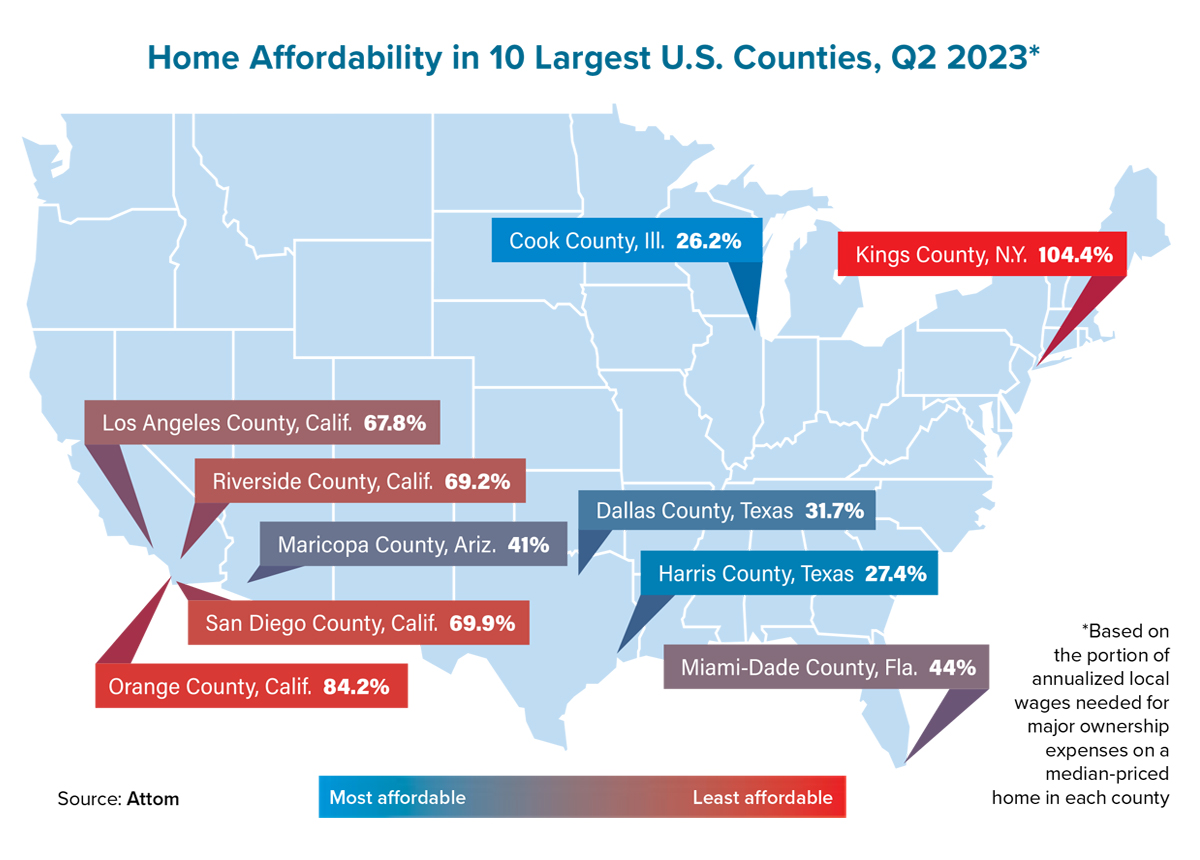In second-quarter 2023, a renewed surge in home prices made it even harder to afford a home, according to the U.S. Home Affordability Report from Attom. This upswing pushed the portion of average wages needed for major homeownership expenses up to 33%, the highest level seen since 2007 and well above the common lending standard of a 28% debt-to-income (DTI) ratio.
It also marked a significant increase from the 25% of average wages required for major homeownership expenses seen in early 2022, shortly after mortgage rates began to spike. The newest figures signal worsening affordability for homeownership across the country. In fact, median-priced single-family homes and condominiums were less affordable in Q2 2023 compared to historical averages in a whopping 98% of the counties analyzed in the report.
The U.S. median home price rose to a record $350,000 in Q2 2023, a 10.2% gain from the prior quarter. This increase came on the heels of three straight quarterly declines, which had many observers heralding an end to the decade-long home price boom. This unexpected price surge contributed to an increase in homeownership expenses that outpaced wage growth, resulting in a significant decline in home affordability. These widespread increases were reflected in quarterly price growth for 524 of the 574 counties (91%) included in the report. Prices jumped by at least 5% in nearly two-thirds of the markets analyzed, while nearly 40% saw prices reach peak levels.
In a bright spot for buyers, weekly annualized wage growth outpaced home price growth for the year ending in Q2 2023 in 74% of these counties. This compared favorably to Q2 2022, when price growth exceeded wage growth in 91% of the same markets.
Although wage increases help to temper declines in home affordability, it’s still an uphill battle for the average buyer. At the national level, mortgage payments, homeowners insurance, mortgage insurance and property taxes cost an average of $1,949 per month, or 33.4% of the average annual income of $70,031. That’s up from the 29.9% DTI recorded in both Q1 2023 and Q2 2022, and it marked the highest DTI since 2007.
Location is always a key factor in affordability and, unsurprisingly, coastal areas continue to lead the charge among the least affordable markets. In fact, 19 of the top 20 counties where major homeownership expenses eat up the largest percentage of wages are located on the east and west coasts, led by Santa Cruz County, Calif. (where 116.8% of annualized local wages are needed to buy a single-family home).
Despite a nationwide average annual income of about $70,000, wages of more than $75,000 were needed to afford a median-priced home in 51% of the markets analyzed in Q2 2023. Each of the top 25 markets with the highest yearly wages needed to afford a typical home were on the coasts, with homes in certain parts of New York and California requiring yearly wages in excess of $300,000.
But on the other end of the spectrum, there are counties where annual wages of $14,000 to $25,000 are enough to purchase a median-priced home: In Cambria County, Pa. (near Pittsburgh), a buyer with an annual income of $14,715 could afford a median-priced home, while in St. Lawrence County, N.Y. (near Syracuse), an annual income of $25,405 will cover the major costs of homeownership.
Although the recent home price surge has dampened affordability, it remains to be seen where the market will go from here. This could be a reflection of the pricing uptick seen each year during the peak purchase season, or it could be an anomaly that is quickly tempered by other economic forces. Factors like mortgage rates and stock market fluctuations will play a key role in whether affordability will continue to worsen in the near future. ●
Author
-

Rob Barber is CEO at Attom, a leading curator of land, property data, and real estate analytics for more than 155 million U.S. residential and commercial properties. He leads teams that diversify the business, improve the quality of revenue and generate returns for investors. He previously served as CEO of Environmental Data Resources, where he helped to scale the company from a niche data publisher into the nation’s largest transaction and business intelligence platform for commercial real estate due diligence. Learn more about Attom at attomdata.com.
View all posts






